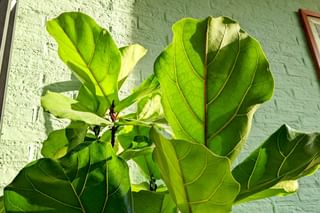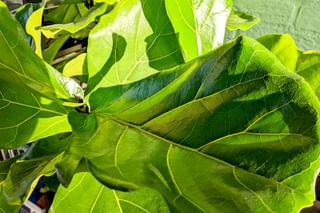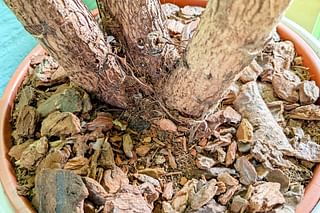How to take care for a Ficus Lyrata (Fiddle Leaf Fig)
The Ficus Lyrata is a great plant to have around the house. With its large leaves and its tree-like trunk, it makes a big statement in any room of your house. In this plant care guide, we're going to look at how you can best take care of your Ficus Lyrata and how to help it thrive.

In this plant care guide, we're going to look at how to take care of your Ficus Lyrata. These are the topics we're going to look at in this plant care guide:
Let's dive right in to explore everything there is to know about your Ficus Lyrata to help it thrive and grow big and strong.
Watering your Ficus Lyrata
Watering your Ficus Lyrata is one of the most important things you can do to make your plant happy. Luckily, it's not very difficult to learn when you follow my watering tips. Watering your Ficus Lyrata might seem a little intimidating if you're just starting out, but it's much easier than it sounds.
If you've taken care of a variety of plants before, watering your Ficus Lyrata is no different from what you're used to. Your Ficus Lyrata loves to be watered regularly, but it also likes to dry out in between waterings. On average, you should water your Ficus Lyrata once per week, but only if the soil has dried out. The soil should be completely dry to the touch to avoid overwatering this amazing plant.
Watering your Ficus Lyrata in the winter
In the winter, when your Ficus Lyrata goes dormant, you won't have to water your houseplant as often as you did in the spring and summer.
In the winter, your plant is dormant and it's recovering from the growing season. Because it's in dormancy, it doesn't need as many nutrients and won't grow as quickly. Because of this, you should water your houseplants less often. On average, you should water your Ficus Lyrata half as much as you did in the spring and summer. This means you should try to water your plant around once every 14 days. Again, make sure the soil is dry to the touch.
Sunlight requirements for your Ficus Lyrata
Watering is the most important thing for your plant, but sunlight exposure is a close second. When you place your Ficus Lyrata in a spot that has the perfect sunlight exposure for your plant, you'll see your plant become happier and healthier.
Your Ficus Lyrata is happiest in a spot that has indirect sunlight exposure. Indirect sunlight means that your plant doesn't get any direct sunlight on its leaves through a window. Direct sunlight will leave burn marks on your plant or make its environment too warm for it to grow properly.
The best spot for your Ficus Lyrata is a spot in the middle of a room with a south or west facing window.
You can read more about the type of sunlight each direction gives you in "Does the sunlight direction matter for your houseplant?".
Sunlight exposure for your Ficus Lyrata in the winter
In the winter, the sun is weaker and lower in the sky during the day. This means that there is less sunlight coming in through the windows and your house is darker during the day.
That's why you should move your Ficus Lyrata closer to windows to give it some extra sunlight exposure. During the growing season this sunlight is often too harsh for your plant, but since the sunlight exposure is weaker, this is fine in the winter.
The perfect soil for your Ficus Lyrata
We've already learned a lot about watering and sunlight exposure, so lets move onto the next most important thing about taking care of your Ficus Lyrata: Soil.
You've already discovered that your Ficus Lyrata likes to be watered occasionally, but also wants to dry out in between waterings, so we'll need soil that can hold onto moisture for a few days and then dry out.
The best type of soil for your Ficus Lyrata is soil that contains coconut fibers to keep the soil light and hold onto moisture for a few days. This type of soil holds onto moisture for a few days, but doesn't compact over time. The coconut fiber helps to keep the structure of the soil intact, so it doesn't become dense over time. When the soil becomes too dense, it can't drain the excess water quickly enough.
Fertilizing your Ficus Lyrata
A houseplant needs energy to grow big and strong. Your Ficus Lyrata gets this energy from the nutrients in the soil.
When you purchase a brand-new bag of soil from the garden center, it's most likely filled with fertilizer for the first 100 days. So when you repot your Ficus Lyrata or just bought your Ficus Lyrata, you won't have to feed your plant for the first 100 days. After this time you will have to fertilize your plant to keep it strong and healthy.
You Ficus Lyrata is a houseplant that you'll need to fertilize occasionally to grow properly. Your Ficus Lyrata doesn't grow very quickly, so you won't have to fertilize it every month, but it does need fertilizer. You can help your Ficus Lyrata stay healthy by fertilizing it twice per year: once at the beginning of spring and once at the beginning of the summer. You can feed your Ficus Lyrata with liquid fertilizer or fertilizer sticks.
You can read more about which fertilizer is best in "What is the best type of fertilizer for houseplants?".
Fertilizing your Ficus Lyrata in the winter
In the winter, when your Ficus Lyrata is asleep and it's not growing (as quickly), you shouldn't fertilize your plant. Your Ficus Lyrata won't use the fertilizer and it'll stay behind in the pot. This will make the soil salty and that will make it a tough place for your plant to grow.
Is your Ficus Lyrata toxic for pets?
Some plants are toxic for your pets and people and should be kept in a safe place, away from pets and children. You're probably asked yourself if your Ficus Lyrata is one of these toxic plants that's toxic to your pets and children.
Your Ficus Lyrata is unfortunately toxic to your pets and small children, so you should make sure to keep it away from them.
The sap of the Ficus Lyrata is toxic to pets and children when ingested. If you notice that your pet has chewed on the plant, be sure to contact a veterinarian right away. The same goes for your children: contact your local GP to prevent too much harm.
Conclusion
In this plant care guide, we've looked at how you can take care of your Ficus Lyrata. We've looked at how you can water your Ficus Lyrata, the best sunlight exposure for your Ficus Lyrata, the best soil for your Ficus Lyrata, how to best fertilize your Ficus Lyrata, and whether your Ficus Lyrata is toxic for your pets and kids.
As I've mentioned before, this plant has been on my wishlist for 3 years and it's actually as great as I imagined it to be!
Thank you for reading this post! I hope it helps you to keep your plants healthy and beautiful! If you're looking for more guides on specific plants, you can always request a plant guide to get a guide for the plant you have trouble with.
Test your plant care knowledge
Quiz completed!
Want to learn more? Sign up for my newsletter to receive free tips in your inbox!
Sign up now!













